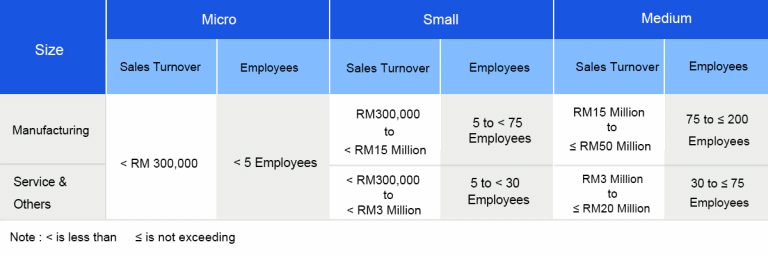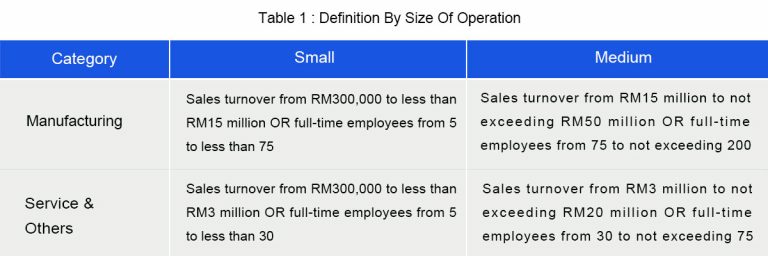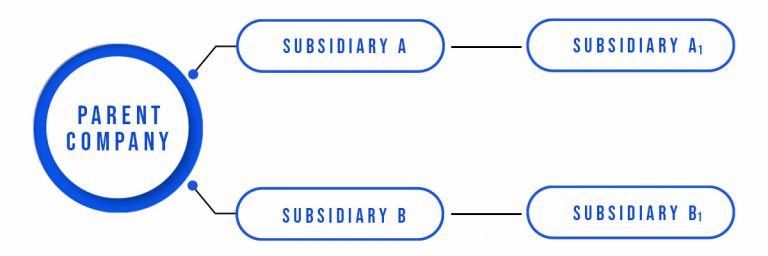Official National SME Definition
SME Definition
Given that there have been many developments in the economy since 2005 such as price inflation, structural changes and change in business trends, a review of the definition was undertaken in 2013 and an SME definition was endorsed at the 14th NSDC Meeting in July 2013.
The definition was simplified as follows:-
- Manufacturing: Sales turnover not exceeding RM50 million OR full-time employees not exceeding 200 workers.
- Services and other sectors: Sales turnover not exceeding RM20 million OR full-time employees not exceeding 75 workers.
A business can qualify as an SME if it meets either one of the two specified criteria, namely sales turnover or full-time employees, whichever is lower.

Detailed definition by category namely micro, small and medium is as follows:

Under the definition, all SMEs must be entities registered with SSM or other equivalent bodies.
It however excludes:
- Entities that are public-listed on the main board; and
- Subsidiaries of:
- Public-listed companies on the board;
- Multinational corporations (MNCs);
- Government-linked companies (GLCs);
- Syarikat Menteri Kewangan Diperbadankan (MKDs); and
- State-owned enterprises.
Details of the definition are as follows:
1. Definition by size of operation:
Microenterprises across all sectors: Sales turnover of less than RM300,000 OR less than 5 full-time employees.
Table 1 summarises the definition for the small and medium categories for the respective sectors.
If a business fulfills either one criteria across the different sizes of operation, then the smaller size will be applicable. For example, if a firm’s sales turnover falls under microenterprise but employment falls under small, the business will be deemed as a microenterprise.

2. Classification of sectors
‘Manufacturing’ refers to the physical or chemical transformation of materials or components into new products.
‘Services’ refer to all services including distributive trade; hotels and restaurants; business, professional and ICT services; private education and health; entertainment; financial intermediation; and manufacturing-related services such as research and development (R&D), logistics, warehouse, engineering etc.
‘Others’ refer to the remaining three (3) key economic activities, namely:
i. Primary Agriculture
Perennical Crops
& Cash Crops
Livestock
Forestry & Logging
Marine Fishing
Aquaculture
Perennical Crops
& Cash Crops
Livestock
Forestry & Logging
Marine Fishing
Aquaculture
Note:
- Example of Perennial crops: rubber, oil palm, cocoa, pepper etc.
- Example of Cash Crops: vegetables, fruits etc.
ii. Construction
Infrastructure
Residential &
Non-Residential
Special Trade
Infrastructure
Residential & Non-Residential
Special Trade
iii. Mining & quarrying
Classification of economic activities for purposes of definition will be based on the Malaysian Standard Industrial Classification (MSIC) 2008 codes. This is to ensure comparability of data from various sources and to facilitate data harmonization across the various providers of SME statistics. However, the list of activities is not exhaustive and may be subject to amendments from time to time.
3. Details of Qualifying Criteria
Sales turnover refers to total revenue including other incomes.
- Full-time employees include all paid workers working for at least 6 hours a day and 20 days a month; or at least 120 hours a month. Full-time workers also include foreign and contract workers. However, the definition excludes working proprietors, active business partners and unpaid family members or friends who are working in the business and do not receive regular wages.
- ‘OR’ basis means that a business will need to satisfy either one of the two criteria used in the definition (whichever is lower).
- If a business exceeds the threshold set under both criteria for 2 consecutive years (based on its financial year / accounting period) then it can no longer be deemed as SMEs. Similarly, a business that is previously large can become an SME if it fulfills the qualifying criteria of SMEs for 2 consecutive years.
- For statistical purposes, all business establishments including foreign businesses that fulfill the SME definition will be classified as SMEs.
Scope of SMEs
In addition to the qualifying criteria i.e. sales turnover and full-time employees, there are additional conditions that must be fulfilled to be classified as SMEs:
1. Types of Establishment
SMEs refer to only pure business entities registered with the following bodies:
- Companies Commission of Malaysia (SSM) either under the Registration of Business Act (1956) or Registration of Company Act (1965) or Limited Liability Partnerships (LLP) Act 2012; or
- Respective authorities or district offices in Sabah and Sarawak; or
- Respective statutory bodies for professional service providers.
2. Shareholding Structure
-
-
- Companies that are public-listed but are in the secondary bourses such as the ACE market, Malaysia Online Trading Platform for Unlisted Market (MyULM) or in secondary markets / SME exchanges / unlisted markets in other countries will still be considered as SMEs for as long as they fulfill the qualifying criteria.
- Subsidiaries of firms in (i) will also be considered as SMEs for as long as they fulfill the qualifying criteria.
-
Subsidiaries refer to entities where the parent company has controlling power over the entities either via:
-
-
- The composition of its board of directors; or
- Has more than 50% of its voting power / share capital (excluding preference shares); or
- Indirectly, through another entity which is a subsidiary that is owned by the parent company (two level subsidiary). For this, again the conditions in (i) and (ii) will apply (refer to Illustration 1.1).
-
These are also pre-conditions to be eligible for Government assistance programmes. It is also recommended that a minimum local equity of more than 50% be imposed depending on the objectives of the programmes, in order to qualify for Government assistance.

Exclusions
The following businesses will not be deemed as SMEs and also do not qualify for Government assistance:
Public-listed companies
Such as Bursa Malaysia or main bourses in other countries.
Subsidiaries of the following entities:
- Public-listed companies on the main board.
- Large firms, multinational corporations (MNCs), Government-linked companies (GLCs), Syarikat Menteri Kewangan Diperbadankan (MKDs) and State-owned enterprises.
In this case, if the parent company in the Illustration 1.1 falls under (i) and (ii), then its subsidiaries (A and B) and their next level of subsidiaries (A1 and B1) are not eligible for assistance.
Applicability of Definition
- The SME definition is applied to all relevant stakeholders implementing SME development initiatives. These include Ministries and agencies2 at the Federal and State levels (including statutory bodies and local authorities), regulators as well as financial institutions.
- This is for identification of eligibility status for SME development programmes, formulation of SME policies as well as the compilation of SME statistics. However, in addition to these criteria, additional eligibility criteria may be imposed by the implementing institutions depending on the scope and objectives of the SME development programmes.
- For purposes of data collection, at all times, the relevant Ministries, Government Agencies, and financial institutions should maintain data on companies and businesses based on both criteria i.e sales turnover and the number of full-time employees. If for any particular reason the stakeholders are unable to compile or maintain both these data, then they should notify the Secretariat.
- All stakeholders involved in SME development programmes are required to harmonize their data collection procedures based on the size and sectoral classifications mentioned. This will enable comparability of data across institutions and provide valuable statistics to better understand the status, issues and development needs of SMEs across all sectors.

Effective Date
The SME definition will come into effect as of 1 January 2014. This means that eligibility for SME development programmes and SME statistics compiled from 2014 onwards shall follow this definition. All statistics compiled prior to 2014 will remain status quo and will not be affected by the definition.
